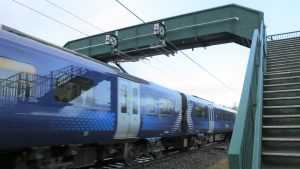 Ricardo has completed the installation of PanMon, a pantograph condition monitoring system at selected sites on Scotland’s mainline rail network.
Ricardo has completed the installation of PanMon, a pantograph condition monitoring system at selected sites on Scotland’s mainline rail network.
The units have been installed on some of Scotland’s busiest routes, including the East and West Coast lines, Edinburgh-Glasgow, North Clyde and Stranraer.
Operating with an average accuracy in excess of 99.5% across each site, the cameras scan 50,000 pantographs each month. Collectively, they capture images at least once a day of every single pantograph travelling on the routes where PanMon is monitoring.
In 2019, Network Rail Scotland commissioned Ricardo to install PanMon at targeted locations across its network as part of a drive to increase the use of predictive maintenance methods across day-to-day operations. PanMon units are positioned to overhead gantries and look down on the tracks to capture 3D and photographic images of each individual pantograph unit on every passing train.
The high-definition cameras capture 3,000 frames per second, meaning even trains travelling at their highest speeds are photographed at 8mm intervals. The lasers will scan the full width of the pantograph to measure its symmetry, as well as pitch, yaw and the condition of the carbon contact strip.
The scans are digitally stored in the cloud by PantoInspect, the Danish technology business that developed the technology, and analysed for new chips and defects, damage to the end-horns, and for wear and tear to the carbon contact strips.
The analysis is relayed direct to Network Rail Scotland’s maintenance teams via customised dashboards that draw attention to negative trends and raise alarms when certain thresholds are breached in a specific incident.
PanMon is a remote condition monitoring system provided by Ricardo to protect Overhead Line Equipment (OLE) by providing real-time assessments of the pantograph units affixed to trains on the network.
On average, the UK railway experiences one ‘dewirement’ a month on its OLE, with the cost of each incident estimated at around GBP 1 million (EUR 1.2 million) and considerably more on high frequency routes or major junctions.
One of the main causes of dewirements are defective pantographs units on the network. A damaged pantograph, particularly a degraded contact strip, can inflict significant wear and tear on OLE apparatus. In extreme cases it can cause a tear-down of the wires, forcing entire route sections to close and await costly repair.
Using the intelligence gathered by PanMon’s cameras, railway infrastructure managers can identify defective pantograph units and work with vehicle owners to prevent further damage.
Share on:



